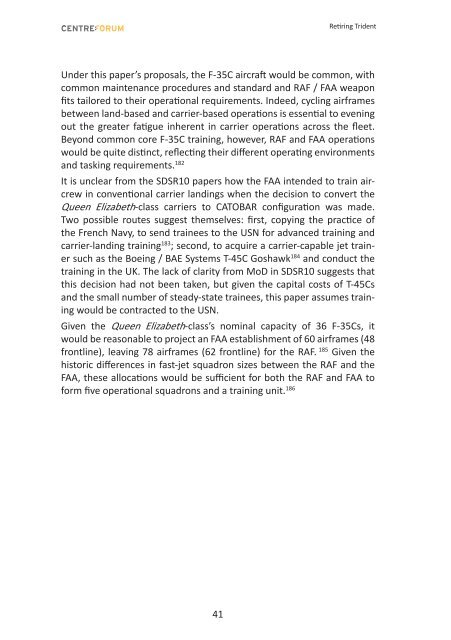Retiring Trident
retiring-trident
retiring-trident
Create successful ePaper yourself
Turn your PDF publications into a flip-book with our unique Google optimized e-Paper software.
<strong>Retiring</strong> <strong>Trident</strong><br />
Under this paper’s proposals, the F-35C aircraft would be common, with<br />
common maintenance procedures and standard and RAF / FAA weapon<br />
fits tailored to their operational requirements. Indeed, cycling airframes<br />
between land-based and carrier-based operations is essential to evening<br />
out the greater fatigue inherent in carrier operations across the fleet.<br />
Beyond common core F-35C training, however, RAF and FAA operations<br />
would be quite distinct, reflecting their different operating environments<br />
and tasking requirements. 182<br />
It is unclear from the SDSR10 papers how the FAA intended to train aircrew<br />
in conventional carrier landings when the decision to convert the<br />
Queen Elizabeth-class carriers to CATOBAR configuration was made.<br />
Two possible routes suggest themselves: first, copying the practice of<br />
the French Navy, to send trainees to the USN for advanced training and<br />
carrier-landing training 183 ; second, to acquire a carrier-capable jet trainer<br />
such as the Boeing / BAE Systems T-45C Goshawk 184 and conduct the<br />
training in the UK. The lack of clarity from MoD in SDSR10 suggests that<br />
this decision had not been taken, but given the capital costs of T-45Cs<br />
and the small number of steady-state trainees, this paper assumes training<br />
would be contracted to the USN.<br />
Given the Queen Elizabeth-class’s nominal capacity of 36 F-35Cs, it<br />
would be reasonable to project an FAA establishment of 60 airframes (48<br />
frontline), leaving 78 airframes (62 frontline) for the RAF. 185 Given the<br />
historic differences in fast-jet squadron sizes between the RAF and the<br />
FAA, these allocations would be sufficient for both the RAF and FAA to<br />
form five operational squadrons and a training unit. 186<br />
41




